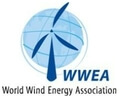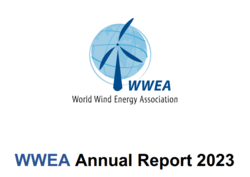News Release from World Wind Energy Association e.V. (WWEA)
Wind Industry Profile of
WWEA Annual Report 2023: Record Year for Windpower Total capacity exceeds 1’047 Gigawatt
Bonn (WWEA) – The year 2023 ended with a new record for new wind turbine installations: In total, the world added 116’065 Megawatt of new capacity within one year, more than ever before. According to preliminary statistics published today by the World Wind Energy Association, global wind power capacity has now passed one million Megawatt and has reached 1’047’288 Megawatt – very close to the prediction published by WWEA in autumn 2023.
The volume of the capacity added is 34% higher than in 2022, when the world added only 86 Gigawatt. This results in a global growth rate of 12,5%, significantly higher than in 2022, when wind capacity grew by only 10,2%.
Amongst the top ten countries, Brazil with 20,8% and China with 19,0% have the highest growth rates. The Netherlands (34%), Finland (22%), Vietnam (24%) and Chile (26%) all had growth rates well above the global average and are now amongst the most dynamic markets, while the previous leaders – the US, Germany, India, Spain and the UK – became underperformers, remaining well below 10%.
Long-term developments: Strong growth continues
With 1’047’288 Megawatt of installed capacity, the world has reached a new milestone. The threshold of 1 million Megawatt of global wind capacity has been crossed 25 years after the world installed 10’000 Megawatt and 15 years after reaching 100’000 Megawatt.
Further growth is expected in the coming years, driven by new policies which have started to take effect in many countries around the world in response to the escalating climate and the fossil fuel crises.
Many countries have stepped up their ambitions to build wind farms on a large scale, both onshore and offshore, backed by concrete policy measures. As a result, the short-term growth potential is also estimated to be high. A tripling of wind power capacity before the end of this decade and a tenfold increase by the middle of the century are not only feasible, but a realistic option.
Repowering, i.e. replacing old and smaller wind turbines by newer, larger and more efficient machines, is an important option for further increasing wind power generation with enormous potential. WWEA has estimated that repowering alone can double today’s wind power generation.
Share of wind power in electricity generation and consumption
The world's installed wind power capacity now meets around 10% of global electricity demand – another important milestone. More than ten countries now have a wind power share of more than 20%, led by Denmark, which generates an astonishing 56% of its electricity from wind. Germany, the Netherlands, Portugal, the UK and Uruguay are among the countries that generate around a third or more of their electricity from wind.
These countries demonstrate that the world as a whole can achieve a 40-50% share of wind power in total electricity generation, as outlined by the WWEA in a long-term scenario. Given the trend towards electrification in the transportation and heating/colling sectors, wind power will play an even more substantial role in the future of global energy supply. Wind power will also be essential for propelling cars and heating/cooling homes.
Barriers to faster deployment
Energy markets are still heavily distorted by fossil fuel subsidies, which have reached new heights in the last two years – due to the fossil energy supply crisis which resulted from the Russian invasion in Ukraine. Removing these subsidies is essential to create a level playing field for zero-emission renewables.
Another major obstacle is time-consuming approval and planning procedures. As WWEA noted some time ago, the average planning and permitting process takes more than five years – in some countries even ten years and more. Permitting should be kept to a reasonable period of time, under normal circumstances two years should be sufficient.
Good community engagement is another prerequisite for faster growth, as local citizens can become active drivers of wind energy development. While a lack of good community engagement can delay or prevent wind projects, community-based wind is a key driver, as many cases have shown.
A more recent trend is that an increasing number of jurisdictions have begun to establish legal standards for this purpose - community energy laws that require wind farm investors to engage in certain forms of community involvement, be it in the form of community shares, low electricity prices, payments to the local community, etc.
WWEA President Dr. Irfan Mirza:
The World Wind Energy Association is committed to overcoming obstacles and leveraging opportunities to ensure wind energy remains a cornerstone of the global transition to renewable energy. We are inspired by the achievements of 2023 and motivated by the challenges and opportunities that lie ahead.
WWEA Secretary General Stefan Gsänger:
However, the significant contraction of some of the major markets is a cause for concern. Onshore wind has been, and must continue to be, the main driver of the global transition to renewables. It delivers the Terawatt hours the world needs, while ensuring the active role of local communities and the distribution of economic benefits across societies.
Continue reading…
Download Full WWEA Annnual Report as PDF
#WWEAwebinar Wind Power Around the World
#WWEApodcast: Where Wind Power Stands Globally
- Source:
- WWEA


